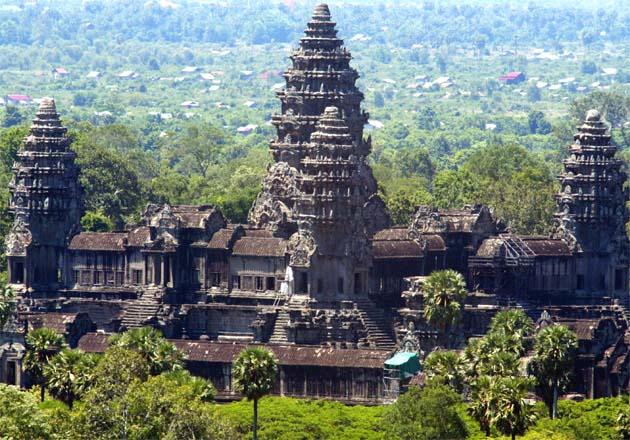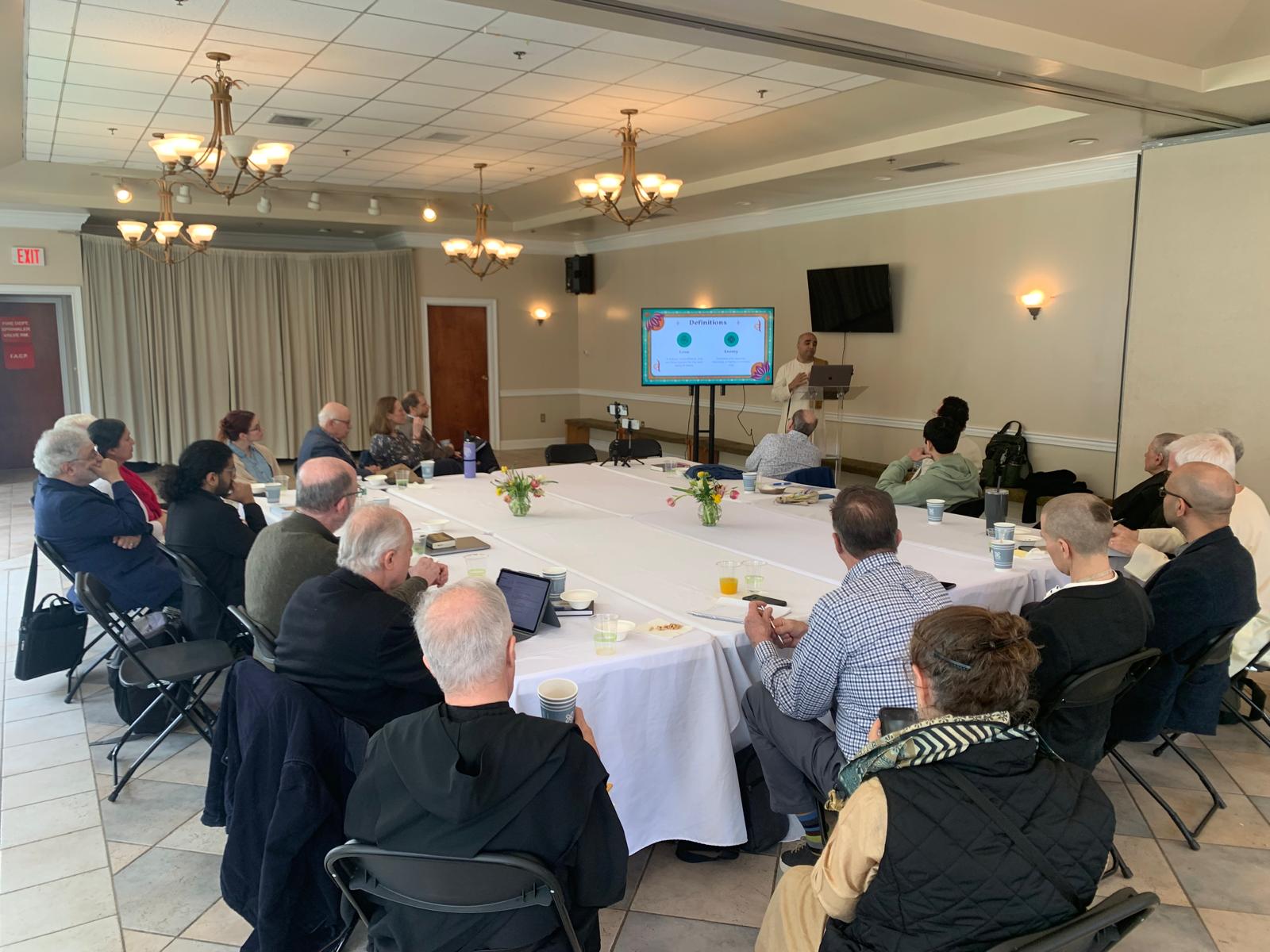Jewel in Kampuchea
By Satyaraj Dasa (Steven Rosen) | Jun 02, 2012

Does it shock you that Vedic culture existed outside India so long ago?” Ta asked me, “No,” I said. “Veda means knowledge, and true knowledge is everybody’s birthright.”
While viewing a recent exhibit at New York’s Asia Society, I met an extremely interesting fellow named Ta Khan— a Cambodian war refugee. Although Ta was familiar with Eastern religion, his knowledge of the Krishna consciousness movement was minimal. He had heard about vedanta, yoga, sanatana-dharma and so on, but like most people who frequent the Asia Society had only a theoretical knowledge of these things. And he was completely unaware that thousands of Westerners had adopted the Krishna Conscious life style.
I was Standing before a beautiful painting from Akbar’s court when Ta approached me. “Are you a devotee of Krishna?” he asked, but before I could answer he stammered, “You’re American! American!”
“Devotion to Krishna is the eternal function of the soul,” I assured him, “it transcends cultural designations.” We continued to look at the exhibit together. Soon he turned again to me, obviously anxious to speak, but he seemed unsure of where to start. Hoping to make it easy for him, I explained, “Krishna is God.
Actually, there is one God, but He is revealed by different prophets according to the intellectu- al and spiritual capacities of a given culture.” I could see he was attentive and eager to hear more.
“No matter where you are born,” I continued, “God can come to you. It’s not that Krishna can come only to a Hindu. If you’re sincere, He’ll search you out. He will either come personally, or He’ll send His pure representative.” I concluded my little sermon: “When His Divine Grace A.C. Bhaktivedanta Swami Prabhupada came to Western shores in 1965, he brought Krishna with him.”
Ta seemed pleased. “I know exactly what you mean,” he ventured. Then with increased confidence he said, “Krishna came to me in Cambodia.”
I thought he was referring to the local concept of God in his country, and I asked, “What form did the Lord come in? What’s His name in your land?”
“Oh, He came as Krishna and also as Rama. He came in the form of the world’s largest Vishnu temple.” Now he had caught my interest. “Wait a minute,” I protested. “The largest Vishnu temple is in Sri Rangam, in South India.” “That’s the largest in India,” he corrected me, laughing, “but the largest in the world is called Angkor Wat, and that is in Cambodia.”
“Angkor what?”
“You may like to joke,” Ta said, his face set with gravity, “but when I was a child my father took me to this massive Vishnu temple, and I have never forgotten the experience. We prayed to leave Cambodia.” He looked at me earnestly. “Life there was so hard. I made a vow before Vishnu that if I ever got out, I would search for His devotees and learn how to worship Him.”
As Ta spoke, tears came to his eyes. It occurred to me that here was a genuine recipient of Lord Vishnu’s mercy. For that matter, so was I. America, for all its opulence, is as unlikely a place to find devotion to Krishna as Kampuchea (Cambodia).
We went to sit in the Asia Society cafeteria. I was completely fascinated by Ta’s experience at Angkor Wat. I wanted to know more. I shared my lunch of Krishna prasadam with him. He shared his past with me. A member of the Asia Society overheard bits of our conver- sation and suggested we go through their private book collection; he was certain he had once encountered some literature on Angkor Wat. And sure enough, we were excited to find quite a bit of literature on the subject. Ta had told me that the name Angkor Wat means, roughly, “the new place,” and we read that “the new place” used to be called, of all things, Yasodapura. I was familiar with the name Yasoda. It’s the name of Krishna’s mother. It seems the temple was constructed in her honor. I had to know more.
As we read on, we learned that south India’s Sri Rangam is indeed considered the largest Vishnu temple in India- but Angkor Wat is bigger still. Ta smiled, proud of his country. “Vishnu is still worshiped in Sri Rangam,” I said, trying once again to defend India’s sancti- ty, “but Angkor Wat has long since become a Buddhist shrine.” But I knew my defense was insubstantial and irrelevant- Angkor Wat still stands as one of the world’s most monumental offerings to God.
The massive Vishnu temple apparently was constructed by the Palava dynasty under King Suryavarman II’s patronage. The Palavas were mostly Vaisnavas, Krishna conscious devotees, and with their great missionary spirit brought Vedic culture from India to many lands.
Angkor Wat, the crown jewel of Palava masterworks, dominates the plain where the Khmer empire — heir to the kingdoms of Funan and Chenla— flourished from the ninth century A.D. Built over a span of some forty years, the temple is one of the world’s most elaborate religious masterpieces, surpassing even the most elegant Christian cathedrals in splendor and magnitude. Worship of Vishnu engaged thousands under its roof until the fall of the Palava dynasty in the fifteenth century, at which time, with the transferal of culture, it be- came a tribute to Lord Buddha. Today, the temple is being partly protected from its most lethal enemy, water, by a network of hidden drains put there in the 1960s.
As Ta read the description of Angkor, it brought back memories of his homeland and of his vow to search out the devotees of Vishnu.
“Its epic symmetries,” he read to me, “begin with the outer gallery, which runs in a circumference of half a mile. Within the gallery, sculp- tures in bas relief retell the pastimes of Vishnu and Rama.” What Ta and I were most happy to read, however, is that Lord Krishna’s pastimes are also depicted on the walls of the great structure. As we read this in an old copy of National Geographic (Vol. 161, No. 5, May 1982), we began to feel closer, as if his background in Kampuchea and my involvement with the Krishna consciousness movement were interrelated. Somehow, they were.
“Does it shock you that your Vedic culture existed outside India so long ago?” Ta asked me.
“No,” I confessed. “I can understand that Vedic culture is our birthright. Veda means ‘knowledge’ and true knowledge is everybody’s birthright. If something is indeed true, it must be true everywhere and for everyone- just like the sun. There’s no question of a Cam- bodian sun or an American sun. The sun is the sun. Vedic knowledge is like that. It is true for everyone. It is the Absolute Truth.
It was getting late. Ta was reflective. Although we had only met earlier that day, we were already old friends. He repeated his story to me; he spoke of his ordeal in Kampuchea; he reminisced about his visit to the Vishnu temple. His prayers did not go unanswered, he told me. Not only was he able to flee Kampuchea with his life, but he was led to Vishnu’s devotees. I was embarrassed. I realized that he was referring to me. And I, in turn, became even more grateful to Srila Prabhupada, who spread the teachings of Krishna consciousness all over the world so that I could be led to Vishnu’s devotees.
Steven J. Rosen (Satyaraja Dasa) is an initiated disciple of His Divine Grace A. C. Bhaktivedanta Swami Prabhupada. He is also founding editor of the Journal of Vaishnava Studies and associate editor of Back to Godhead magazine. He has published more than twenty-five books in numerous languages, including Essential Hinduism (Rowman & Littlefield 2008); The Yoga of Kirtan: Conversations on the Sacred Art of Chanting (FOLK Books, 2008); Krishna’s Other Song: A New Look at the Uddhava Gita (Praeger, 2010); The Jedi in the Lotus: Star Wars and the Hindu Tradition (Arktos Media, 2010); and Food for the Soul: Vegetarianism and Yoga Traditions (Praeger, 2011).












